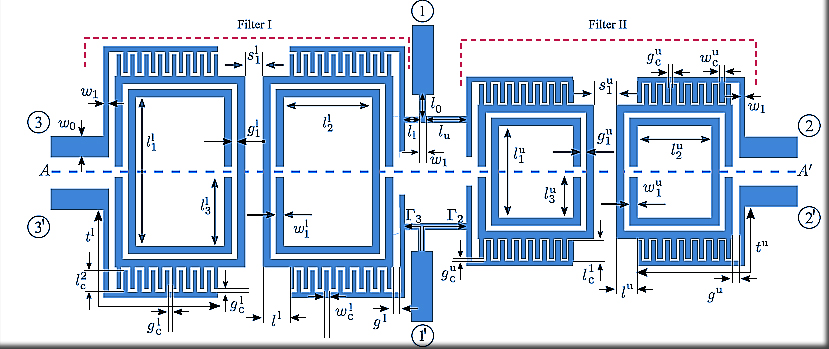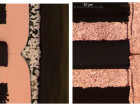Compact Balanced-to-Balanced Diplexer Based on Split-Ring Resonators Balanced Bandpass Filters
A compact balanced-to-balanced diplexer composed of two balanced bandpass filters is proposed in this letter. The balanced filters are implemented using compact edge-coupled square split-ring resonators. The design methodology is based on the standard coupled-resonators filter synthesis procedure.
First, each filter is independently designed. Then, they are connected to a common differential input port in order to achieve the desired diplexing operation, with the pertinent adjustments to take into account the loading effect of the second filter. Magnetic coupling inherently prevents common-mode transmission.
An illustrative prototype example is provided with simulations and measurements to demonstrate the benefits of the proposed topology.

The interest in balanced/differential circuits has considerably increased along the last couple of decades. In comparison with single-ended signals, differential signals offer enhanced electrical performance in terms of signal-tonoise ratio, noise immunity, crosstalk, and electromagnetic interference (EMI). In recent years, with the requirement for multi-band services, differential diplexers have attracted the interest of the microwave community. A well designed balanced-to-balanced diplexer must simultaneously provide good differential-mode (DM) performance, strong commonmode (CM) rejection, and high isolation between the output ports. Several strategies have been proposed to achieve all those goals.
The result shows a good agreement between simulations and measurements. Measured results exhibit passband center frequencies at 1.47 GHz and 2.19 GHz, with fractional bandwidths of 11.5% and 7% and insertion loss (IL) level of 0.94 dB and 2.2 dB, respectively. The experimental DM isolation (Iso) is better than 40 dB for the lower band and about 40 dB for the upper band. In addition, the measured CM rejection is about 40 dB and 45 dB for the lower and upper-band channels, respectively.
Note that a third TZ appears in the transmission response when the two differential filters are assembled to build up the diplexer. This is a natural consequence of the imposed design goals of the T-junction.
A comparison with previous contributions is included in Table I. This table demonstrates that the proposed structure provides the most compact design, thanks to the use of EC-SRRs to implement the filters by halving the area of the smallest previous contributions. In addition, in terms of CMRR, the proposed diplexer is found to be very competitive. Moreover, high DM isolation is observed in both passbands.
Authors: Armando Fernández-Prieto (Member IEEE), Aintzane Lujambio, Ferran Martín, (Fellow IEEE), Jesús Martel (Senior Member IEEE), Francisco Medina , (Fellow IEEE), and Rafael R. Boix, (Member IEEE).
- Balanced-to-Balanced Microstrip Diplexer Based on Magnetically Coupled Resonators - 4th April 2018
- Degolding and Retinning Processes On Leadless SMD Packaged Devices - 16th February 2018
- Compact Balanced-to-Balanced Diplexer - 15th February 2018




